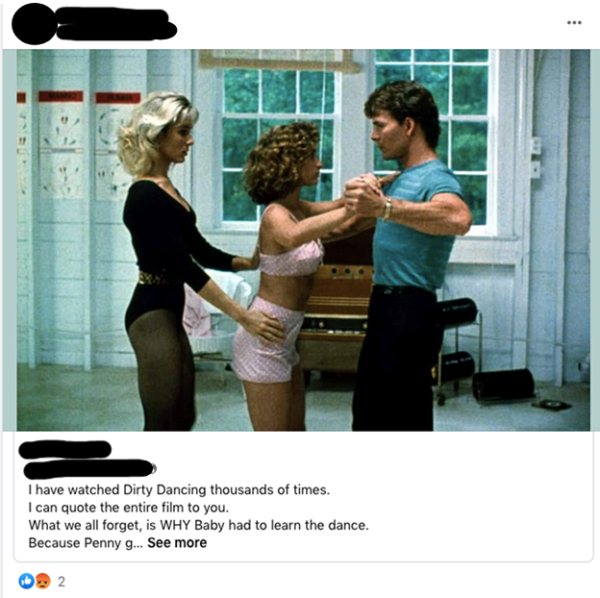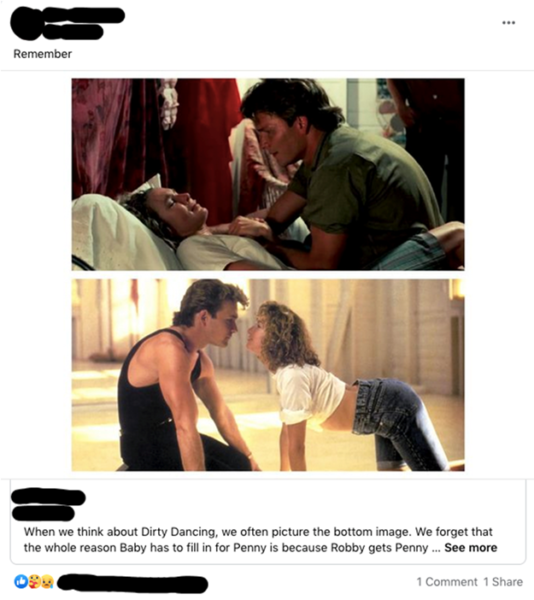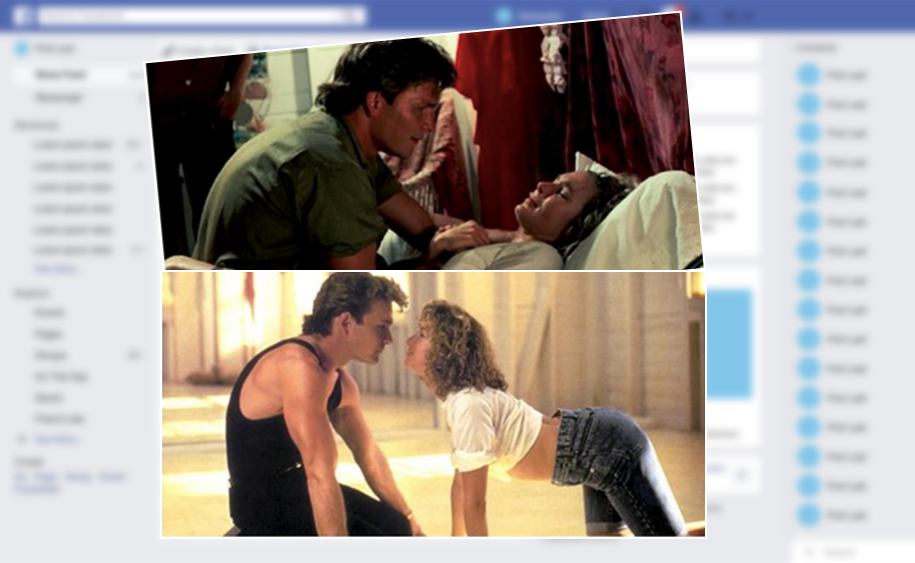I was in a Zoom meeting when I got the Variety news alert about Roe v. Wade being overturned. Given our current moment, this constellation of virtuality, entertainment, and mortally devastating news felt depressingly familiar. Also familiar was the disorienting experience of opening Facebook soon after to find my timeline flooded with images of Jennifer Grey and Patrick Swayze in “Dirty Dancing” (1987).
When I looked for information about where people would be gathering to protest the Supreme Court’s decision, I found instead movie stills from the popular dance film set at an early ’60s Catskills resort.
Two versions of this slacktivist meme were predominant in my timeline in the hours and days after Roe was overturned.

“I have watched Dirty Dancing thousands of times.
I can quote the entire film to you.
What we all forget, is WHY Baby had to learn the dance.
Because Penny g… See more”

“Remember
When we think about Dirty Dancing, we often picture the bottom image. We forget that the whole reason Baby has to fill in for Penny is because Robby gets Penny … See more”
I am part of the “we” invoked by both memes. I saw “Dirty Dancing” for the first time at a birthday party for a friend who was turning seventeen, the age Baby is in the film. Soon after, many of us got Jennifer Grey’s perm and started wearing jean shorts. Have I watched “Dirty Dancing” “thousands of times”? No. But, if called upon, I could certainly quote its most famous line (“Nobody puts Baby in a corner”). I could also do a passable job if asked to Karaoke “I’ve Had the Time of My Life.” When I think about Dirty Dancing, though, I would not have pictured Baby on her knees before Johnny. And I would not have said the film is about the dangers of back-alley abortions. Because it really isn’t.
Like many mid-budget American films of the 1980s, “Dirty Dancing” is about class privilege, the sexualization of young women, and aggressive soundtrack sales.
The plot point about abortion in these memes is just that, a plot point. The film is much more invested in devising scenes that slyly reveal Jennifer Grey’s nipples than in the tragic story of the working-class dance instructor seduced and abandoned by one of the wait staff at Kellerman’s resort.
It’s true that Penny’s unwanted pregnancy and back-alley abortion move the plot forward, but it’s ultimately subsumed by the kind of imagery that the memes are using to draw users’ attention: sexy images of Johnny and Baby. If “Dirty Dancing” is making an argument about the dangers of back-alley abortions, it does so strangely. The brief glimpse we get of a sweaty, moaning Penny on a bed with ever so subtly bloody sheets is followed by an unsubtle scene in which Baby and Johnny have slo mo sex that also involves a lot of sweat and moaning.
No part of that scene (or the subsequent scenes of their hook ups) involves Baby producing a diaphragm or asking Johnny where he keeps his condoms.
The central pleasure offered by “Dirty Dancing” is watching Baby and Johnny dance and have sex to an omnipresent 1950s soundtrack. Perhaps because the film was shot in an era when federal laws protected abortion, the film’s heavy lean into nostalgia opened space for the filmmakers to address the dangers of illegal abortion in a film destined for cineplexes. That’s reasonably admirable. But, according to the memes, that was not the message “we” took away from that movie.
I re-watched the film this week to see what this member of the “we” thought were its takeaways. I saw a few. Much of the film involves an irritable Johnny teaching a clumsy Baby to dance through yelling and pushing. These scenes taught me that girls need to let men lead, and, instead of thinking, look into men’s eyes for direction. That jives with other, similar messages I received in the ’80s.
The lift, when Johnny holds Baby in the air above his head, is the film’s most iconic image and, because she fails to achieve the lift when they dance the Mambo at The Sheldrake, it is the cinematic resolution of the Johnny/Baby story arc. I guess this means that girls should judge their worth by whether they are brave enough to allow men to lift them up? Yuck.
Since Baby gets the $250 for Penny’s abortion from her Dad, learns to dance Penny’s part in the Mambo, brings her doctor father to Penny’s side after the abortion goes wrong, and then sneaks out to have sex with Johnny, re-watching “Dirty Dancing” also showed me that sex is dangerous for working-class women but that privileged white girls can have sex with impunity. Though it is evident to me now, I do not believe this was the film’s intended message.
We live in a moment when infotainment may be our readiest access to and avenue for expressing responses to political crises. But what is that doing for us? The more I look at these memes, with their clickable invitation to “… See more,” the more I see the memes replicating what the film does to Penny. They subsume her story.
Sure, the text in these memes is cut off due to some manipulative, mysterious Facebook style guide rather than an explicit occlusion of what actually happened to Penny. And, sure, these memes were served to me because my Facebook world is a bubble of perimenopausal women who believe in reproductive rights and were seeking generational solidarity due to the loss of our bodily autonomy.
I don’t doubt that many Gen X women, including those who created these memes, genuinely care about reproductive rights. The memes invoke nostalgia for the 1980s the way that the film invokes nostalgia for the 1950s and ’60s.
I mean, I get feeling some nostalgia for the 1980s right now: the year this film came out is the same year my best friend and I took a bus to Planned Parenthood to get prescriptions for the pill. We knew that if we got pregnant, we would not be forced to carry the pregnancy to term.
The problem is not that we’ve forgotten why Baby had to learn the dance.
The problem is that today’s 16- and 17-year-olds do not have the rights and freedoms that we did when we watched “Dirty Dancing.”

